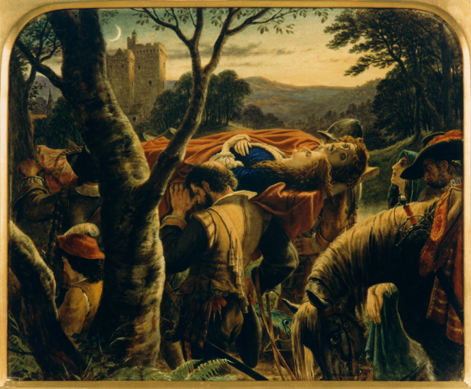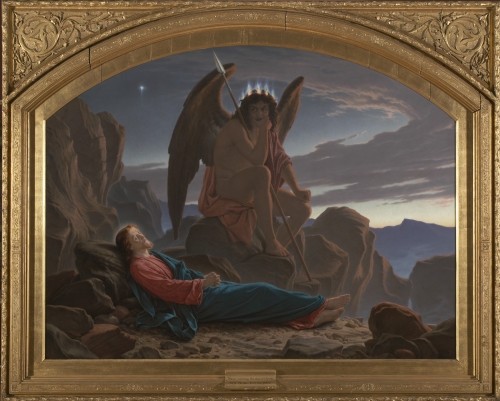Noel Paton and the Pre-Raphaelites: Scottish Collections and Connections
An exhibition to accompany the Wildering Phantasies conference
Lamb Gallery, Tower Building, University of Dundee
8 July - 10 September 2011
Mon-Fri 09.30-20.30 Sat 09.30-16.30

The Dowie Dens o' Yarrow by Sir Joseph Noel Paton (1860)
University of Dundee Museum Services
This exhibition accompanies a major international conference on the Pre-Raphaelites organised by the School of Humanities at the University of Dundee. It focuses on Scottish links to the Pre-Raphaelites and showcases some rarely seen works in local collections.
The Pre-Raphaelite Brotherhood was founded in 1848 by painters Dante Gabriel Rossetti, John Everett Millais and William Holman Hunt. They were later joined by painter James Collinson, sculptor Thomas Woolner and critics Frederic George Stephens and William Michael Rossetti, Dante's brother.
Many other artists became associated with the movement, although they were never formal members, including Edward Burne-Jones, Ford Madox Brown, Frederick Sandys and William Morris.
The Pre-Raphaelites reacted against the formal, academic style of art popularised by the establishment. They demanded a return to the art of the early Renaissance before the work of Raphael, emphasising truthfulness in subject and treatment.
The Brotherhood was based on the following principles:
- To have genuine ideas to express;
- To study Nature attentively, so as to know how to express them;
- To sympathise with what is direct and serious and heartfelt in previous art, to the exclusion of what is conventional and self-parodying and learned by rote;
- And, most indispensable of all, to produce thoroughly good pictures and statues.
As a formal group, the Pre-Raphaelites only existed for a few years, but their influence in art and literature was considerable. Many Scottish artists drew on their ideas, and some of their work is included in this exhibition - particularly that of Dunfermline-born Sir Joseph Noel Paton (1821-1901). Paton was a close friend of Millais, who invited him to join the Pre-Raphaelite Brotherhood. Paton declined, but continued to be influenced by their ideas. Included in the exhibition is material from the Noel Paton Archive recently acquired by Fife Council Museums and not previously exhibited in public.
The exhibition also features material from Dundee Art Galleries and Museums, Aberdeen Art Gallery, Perth Museum and Art Gallery, the Royal Scottish Academy, the St Andrews Preservation Trust Museum and the University's own collections.
Visit the Pre-Raphaelite page of our Fine Art Collections website.
Scottish Art and the Pre-Raphaelites
Although the Pre-Raphaelite Brotherhood was an English movement, it had a number of important connections to Scotland and Scottish artists. The first important champion of the Pre-Raphaelites was the critic John Ruskin, who was introduced to the work of J E Millais by the Aberdeen-born painter William Dyce. Ruskin's celebrated Edinburgh Lectures of 1853 included this description of the movement:

Satan watching the sleep of Christ by Sir Joseph Noel Paton (1874)
Fife Council Museums
"Pre-Raphaelitism has but one principle, that of absolute, uncompromising truth in all that it does, obtained by working everything down to the most minute details, from nature and from nature only."
William Dyce was one of several Scottish painters whose work then began to follow Pre-Raphaelite principles. Fife-born Sir Joseph Noel Paton and his brother Waller Hugh Paton both attended Ruskin's Edinburgh Lectures and also came under Pre-Raphaelite influence. Noel Paton was a close friend of Millais, while the Edinburgh-born painter and poet William Bell Scott was friends with Rossetti and Holman Hunt. Many other Scottish artists began their careers in Pre-Raphaelite style before finding their own distinctive approach, most notably William McTaggart.
The interest in medievalism shown in later Pre-Raphaelite works was taken forward by William Morris whose Arts and Crafts movement was also an important influence on the Celtic Revival artists led by Patrick Geddes (Professor of Botany at University College, Dundee).
Sir Joseph Noel Paton (1821-1901)
Noel Paton was born in Dunfermline to Joseph Neil Paton, a damask designer and manufacturer who was also art master at Dunfermline Art Academy. All three of Joseph's children became successful artists - Noel's brother Waller as a landscape painter and his sister Amelia as a sculptor. Noel's father was a collector of ancient Scottish armour and weapons, and he inherited a fascination for history, folklore and religious subjects.
Paton met Millais in 1843 while studying at the Royal Academy and the two became friends. Millais later invited him to join the Pre-Raphaelite Brotherhood but Paton declined. However the theories of the Pre-Raphaelites continued to influence his work, which was often loaded with spiritual and allegorical significance. Even the magical fairy paintings that he his best remembered for were painted in a very detailed and precise style similar to that of the Pre-Raphaelites. His brother Waller's landscapes were also strongly influenced by these ideas.
Paton spent the rest of his career in Scotland where his paintings became highly popular. In later life he focused increasingly on religious paintings which were widely reproduced as engravings. In 1867 he was knighted and was appointed the Queen's Limner (official artist) for Scotland. One of his children, Diarmid Noel Paton, became a noted physiologist and was a childhood friend of D'Arcy Thompson, Professor of Biology at University College, Dundee.